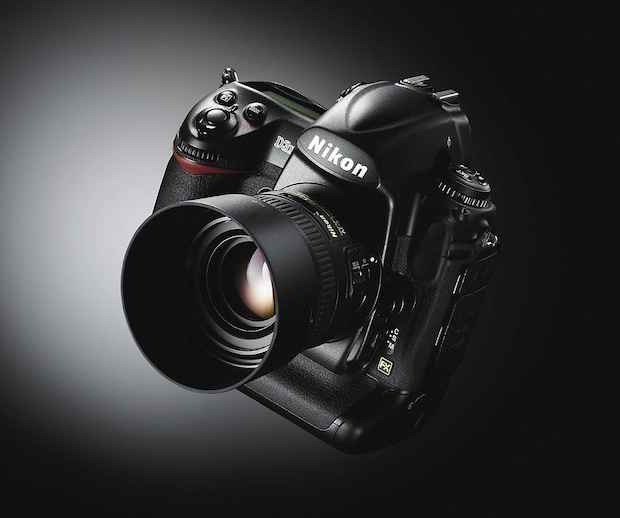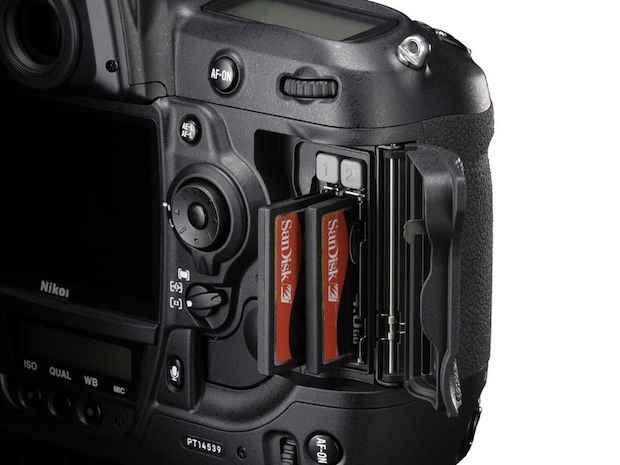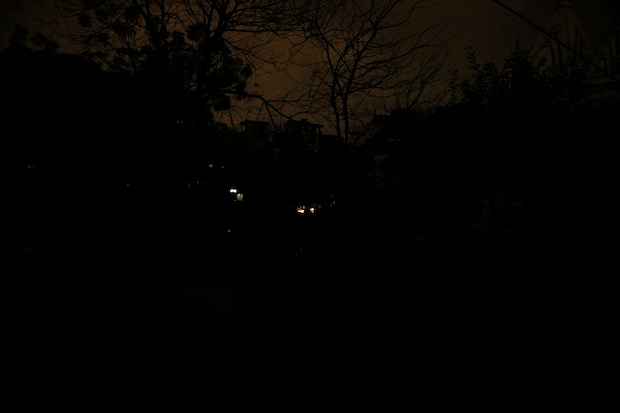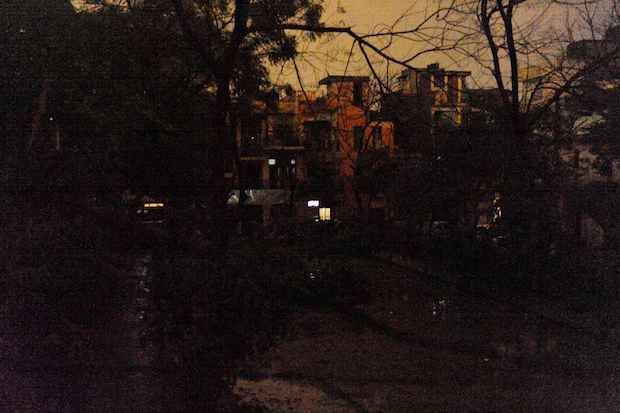Nikon D3s - A killer professional body and the low-light champ detailed review
Any photographer worth his prime lens would have heard of the Nikon D3s. A full size, full frame, professional-grade body, the D3s is Nikons offering to professionals who don't quite need a very high megapixel output, but demand speed and do a lot of shooting in low, or less-than-ideal light. Pro bodies such as this one are definitely not for the tentative enthusiast. They weigh well over a kilogram, the D3s tips the scales at 1240 grams. Add one of the better Nikkor lens, and the weight of the package will exceed two kilograms. That's a lot of camera to lug around, although photographers would hope the inconvenience is offset by the image quality, functions and usability.

Look and Feel: A seriously professional body
Looking at the D3s face on, one cannot help be impressed at the sheer size of the camera. Those wanting sleek cameras will find the Nikon D3s to be a sumo-grade heavyweight, while pros will appreciate the heavy, solid lines and reassuring heft, and the substantial grip that makes even the D300s seem like a cheap toy. In fact, the sturdy magnesium-alloy frame has been given one of the chunkiest rubber grips your money can buy. As a result, the Nikon D3s is very comfortable to hold. Ones fingers do not have to bend, and at no point does hand-space feel insufficient. As one would expect with such a large grip, all the buttons are well spaced out, sufficiently to render them usable even if you are wearing gloves. Quite a bit of the surface is metal as well, and on the whole, the D3s looks and feels rugged enough to endure years of hard use with the elements - no doubt as Nikon intended.
[RELATED_ARTICLE]The integrated vertical grip makes the Nikon D3s look even bigger, but in fact, if you add a battery grip to the Nikon D700, (that doesn't have an integrated vertical grip), it will become marginally higher than the D3s, and slightly heavier. The vertical grip is a must for professionals who need to take portrait-inclined shots without altering the camera position and having to tilt ones hands. Equally important, when paired with costlier and larger FX lenses, the D3s doesn't feel unbalanced. Lighter bodies tend to tip forward because of the disproportionately high weight of the lens. The rubber coating on the vertical grip is not as substantial as the one on the horizontal grip, but it is sufficient. The shutter release button has a nice positive feel, and the shutter makes a reassuring click. In comparison, the Nikon D300s has a very dead feel to it. The Nikon D7000, (read its full review here), and Canon EOS 7D, (click here to read its full review), are closer to the solid sound of the D3s' shutter.

In keeping with norms for such bodies, the Nikon D3s receives weather sealing in the form of dust and moisture resistant gaskets around buttons and controls, and of course the display. There are two status LCDs - the traditional one that is perched atop the camera, and the other one located below the main LCD. Nikon's control system is different from Canon, and will take getting used to by someone who hasn't handled a Nikon dSLR before, but if you're graduating from a Nikon D300s you will feel comfortable - although initially, you will have to adjust to controls having been moved around, as well as a few extra buttons. On the front of the camera, to the left, there are two extra buttons. Both of these can be configured to perform a range of functions including the virtual horizon function, which is useful for levelling a shot.
The ISO, White Balance and image quality settings are now neatly below the second status LCD, and this is quite intuitive to use once you get used to it. However, while changing the ISO settings, you can view the changes in either status LCD - which is needed. These LCDs have illumination, activated by flicking the power on switch further to the right. This illumination looks better than the Nikon D300s' system, where the LEDs are visible and brightness of the display is uneven.
To the front of the camera, just near the lens contains the switch for changing focus modes which are single servo, continuous, and manual focus. On the side of the viewfinder housing is the ring control for switching between metering modes - spot, expanded spot and 3D metering. There is a lock button set in the ring, to prevent accidental movement. The actual menu of the D3s is deep, and multi layered. It's mind boggling how many settings this camera has and we figure it will take some time to configure everything for your use. In fact, even people upgrading from a D300 will have a fair bit of learning to do, as the D3s has numerous options, and really, even pros will take some time to fine-tune everything to their requirements.
Click next to read about the features of the Nikon D3s
Features: Packed to the gills - but how many will you actually use?
When a product has a manual that is more than 300 pages long, you know you are in trouble if you don't read at least some of it. Most users will never reach the upper limits of what this camera is capable of. What follows is a list of its key features, with some cryptic ones deciphered.
- 12.1-megapixel, full frame (36 x 23.9mm) sensor
- Video recording 1280 x 720 pixels @ 24 fps
- Native ISO range from ISO 200 to ISO 12,800. ISO 25,600, 51,200 and 1,02,400 are supported as extended options
- 9 frames per second in FX mode (JPEG)
- 51-point autofocus system, with 15 cross-type points (Multi-CAM3500FX sensor)
- Dual CF card slots
- Auto focus calibration setting for up to 20 different lenses
- Kevlar/carbon fibre composite shutter rated at 3,00,000 cycles
- 3-inch, 9,20,000 pixel LCD monitor
- Magnesium-alloy body with moisture and dust sealing
- 1005-pixel colour metering system
- Powerful 2,500 mAh, 28 watt-hour battery
Being a pro body, means the Nikon D3s does without an auto mode - sorry newbies. The D3s is obviously the spiritual successor of the D3 - a best selling model for Nikon, and their first body with a full frame (FX) sensor. The Nikon D3s has a relatively low pixel density for a full frame. Consider that a Canon EOS 7D with a sensor that is two and a half time smaller (334 cm2 VS 864 cm2), has a 50 per cent higher resolution at 18 megapixels, and you'll see the main charm of the D3s - light gathering. This does not mean you cannot use it while shooting in bright daylight or well lit conditions. It is just that the D3s is far better equipped than most other dSLRs at capturing detail in dim conditions and making the best of poor light. With a native ISO range that extends to 12,800, the D3s makes no bones about its capabilities. Extended modes further extend ISO to 25,600, 51,200 and 1,02,400. This is simply monstrous, an ISO 1,02,400 equates to shooting in total darkness, although, obviously, image quality would not be great.

The Nikon D3s shows off its dual CF card slots. These can be configured in a number of ways from the in camera menu
The D3s can accept FX and DX lenses. With the latter, the 1.5x crop factor is taken into account, meaning you get a resolution of around 5-megapixels. With JPEG files, in FX mode, the D3s is speedy managing 9 fps. Use DX mode (5 megapixels) and this rises to 11 fps - pretty impressive, although the Canon EOS 7D manages 8 fps at 18 megapixels and costs less than a third of the Nikon D3s. The D3s is therefore, very suitable for fast action scenes or where a good shot is needed under adverse conditions. In RAW mode, the speed falls, and in RAW JPEG (fine), we found the camera pausing for half a second after every 3-4 shots, this while using a Sandisk Extreme 3 CF card, capable of 60 megabytes per second.
[RELATED_ARTICLE]You can select between 3D Matrix metering, center-weighted metering and spot metering depending on the conditions and shot desired. The D3s offers find grained control over exposure with four modes - programmed auto, where the camera selects shutter speed and aperture based on current ISO and exposure compensation. Shutter priority where you select the shutter speed and the camera handles everything else. Aperture priority mode is the third mode that allows you control over aperture while the camera chooses other settings to suit the conditions. The fourth mode is manual exposure - and really, to get the most out of the D3s, and to tweak the shot to your liking, this is the mode you should stick to - obviously, assuming you know enough about the variables involved.
The viewfinder is large and bright - full frame cameras are in a league of their own here and this one is good enough to rely on for manual focussing. The 51 focus points are all very good, but unlike the D300s that has good frame coverage, on the D3s they seem fairly clustered around the middle. Even the EOS 7D with 19 cross-type points, has better frame coverage. Unlike the D3, the D3s includes a built in sensor cleaning mechanism that works via vibration caused by peizo-electric crystals. Obviously, the camera should be held with the sensor perpendicular to the floor, so that the dust falls to the adhesive strip mounted below the sensor. Throughout the month of using it, we didn't find the big sensor gathering much dust, despite use in Delhi's very dusty environs, and changing lenses more than a few times.
The dual CF card slots can be configured too - one can be set to record NEF while the other records JPEG. Or you could set one up as a backup to be switched to, when the other card runs out of space. Or the same file can be written to both cards i.e. redundancy. Video recording is touted as a feature, and 720p video recording is seamless on the D3s, but this is merely an add-on, to what is clearly a still-image device. 1080p recording is lacking - the Canon EOS 5D Mark 2 scores here.
Criticism, if any, is definitely going to be levelled around the megapixel rating. 12 megapixels was considered fairly mediocre, especially given that Nikon had a D3x with a 24-megapixel sensor, a year prior to the release of the D3s. However, Nikon doesn't manufacture sensors, so there is not much they can do. Many people wanted the successor of the D3 to have a resolution of at least 18 megapixels, however, that was not to be. Given that cameras like the Canon EOS 5D Mark 2, that is much cheaper, has a 21-megapixel sensor, Nikon seems lacking here. Resolution is important to get crops, and with good lighting and at lower ISOs, higher resolution cameras gain a distinct edge. Of course, with low light, the larger the photodiode microsites, the better, and this is where the D3s is expected to earn its price.
Click next to read about the performance of the Nikon D3s
Performance: Focussing
This is not one of the easier parameters to test, but after taking more than 700 shots with the D3s, we feel capable to provide a quick assessment. For the most, the D3s focusses very accurately and is quite fast. At this point, we tried both single point AF and continuous AF. Firstly, we'd like to note that, like other cameras, the D3s' focussing is very dependent on the type of lens used. Even though we used the excellent 24-70 f2.8, which is quite a fast lens, we figure the lens was limiting the focussing. Obviously, in even decent ambient light the D3s focusses speedily, and accurately. In bright light, it is overkill - no issues whatever. In dark conditions, and we're talking a dark street with a feeble streetlight, or even the tail light from a moving car, the D3s will lock on accurately. All you need in even a very dark scene is some contrast within the focus coverage. However, when shooting objects of uniform darkness, with no highlights or contrasty regions, the 24-70 refused to focus. At this point, comparisons come to mind. The D3s is at least as good as the Nikon D300s. The D300s does have a theoretical advantage, on account of its focus-point coverage being more spread out, and therefore getting a wider area to lock on to. The Nikon D7000 is also very accurate, but slower than the Nikon D3s. The EOS 7D is a different beast, and although it has a sparser 19-point system, it is well spread out, and if memory serves, every bit as fast. In fact, the focussing system on the 7D could well be faster than the D3s, it certainly seems to focus more unerringly on moving objects.
.jpg)
The D3s focusses fast and very accurately. At f2.8 on the 24-70, be prepared for some startling and pleasing, (if not totally realistic), out depth of field as seen here. Settings: ISO 200; shutter speed: 1/125 sec; Aperture: f3.5; focal length: 62mm; metering: matrix; mode: full manual
Continuous focussing is useful when you wish to track moving objects and uses all 51-points and 3D tracking, which is essentially tracking on the basis of colour, contrast and distance from the camera body. AF point selection functions flexible, but the Canon EOS 7D has a better selection system, with the ability to use clusters of focus points together. Once again, the level of adjustments offered in the menu to fine-tune autofocus and allied functions is mind boggling, and we constantly had to refer to the manual to try some of these out. 3D tracking works well, and the D3s is able to achieve and maintain focus of moving vehicles, running children, sports such as cricket matches and even live music shows at dimly lit indoor stadiums - pretty impressive stuff. The only way to fool the system, is if you have a number of moving objects of the same colour - such as three or four white cars, or football players with identical clothing. However, given the number of out-of-focus shots, we feel the Canon EOS 7D has a slight edge when focussing on moving objects.
We never once felt the focussing system to be a limiting factor, except when working with very dark scenes, with no contrast for get lock on. Out of the 770 odd shots taken, some 38 frames were out of focus. Out of these, half were attempts made fiddling with various menu settings to gauge results and don't really count as poor shots.
AFS Nikkor 24-70mm f/2.8G ED
The Nikon 24-70 f2.8 was sent to us with the D3s. This full frame lens has a fixed aperture of f2.8, which is a standout feature, since one can shoot, ignoring the effect zooming has on light gathering. Unfortunately, this lens does not have image stabilisation built in, but to be honest, given the wide range of lighting conditions it can work in, you seldom need to go below a shutter speed of 1/20 seconds.
This lens is built to compliment the larger bodies and it is solidly built, almost entirely out of metal, with a metal outer barrel and even the lens barrel is metal. The focus ring and zoom ring are also well constructed with luxurious rubber grips. They also have a nice positive feel. There is no zoom creep, although a zoom lock has not been provided. Overall, the lens looks built to last, and even features some weather sealing to protect against light moisture and of course, dust. The lens can work in autofocus mode, or auto/manual focus, meaning that you can essentially leave the latter setting on, even for autofocussing. This is important in case you forget about your lens being on autofocus and try manual focussing, which can damage the lens.
The 24-70 is an extremely sharp lens. When stopped down, it produces very clean detail even at the corners. Thanks to the large lens hood, external refractions are kept away from the lens, which is pretty resistant to flare anyways. Vignetting is not a problem with this lens, and corners are bright. This glass has the ED moniker, along with the gold band around the barrel, which designates a hard flourine coating on the outer lens that is supposed to prevent chromatic aberrations. This really works and CA is well controlled. So kiss the purple fringing goodbye. The output is clean, with minimal anomalies of any sort. This is a very good lens, offering excellent image quality, albeit one with a limited focal length.
Performance: Image Quality
Although we're looking at the image quality of a camera body here, it is hard not to comment on the image quality provided by the lens as well. In fact, lenses play a far greater role than bodies. The 24-70 f2.8 lens Nikon sent us is an excellent compliment to any full frame camera, please read about it in the adjacent box. Admittedly, the focal range is rather limited to wide angle shots with moderate zoom, and something like the 24-120 is much more convenient for an all-in-one, walkaround lens. However, the 24-70 does gather a lot of light, and thanks to the fixed aperture, you needn't fiddle with aperture or shutter speeds while zooming, since the lens essentially lets in the same amount of light at 24mm as it does at 70mm. Coupled with a body like the D3s, we held perhaps, the best combination for shooting indoors and after dark. The only way you could do better, is to get a faster prime.

A high ISO shot, taken in complete darkness. This is mainly to compare with the next shot beneath, shot at an unthinkable ISO 1,02,400. We just about achieved focus by using the light from the windows as you can see. Settings: ISO 16,000; exposure time: 1/30 sec; focal length: 24mm; Aperture: f2.8; program mode: manual
Since the D3s was obviously designed with the professional who shoots indoor sports, or modelling shows, or even live music performances, all of which occur in typically ambient or dim lighting, and it is expected to deliver great quality high ISOs. Tried to imagine a live rock show with bright lights? Neither could Nikon. One of the things we learned early on, was that with high ISO shots, not to rely on JPEG files, even with noise reduction turned off. At ISO 3200 and above, the post processing that is done on JPEG files rears its ugly head. So when shooting at ISO 3200 and above, you might want to stick to RAW (NEF), where this is more headroom that you can extract using post processing.

This is a shot at ISO 1,02,400. The same conditions - complete darkness. As you can see, from the previous shot, in such conditions, and at even an ISO of 16,000 not much is captured. ISO 1,02,400 manages to capture detail that the eyes themselves could not make out, like the red colour of the building. The cost is, of course, that there is a lot of noise. Settings: ISO 1,02,400; shutter speed: 1/30 sec; Aperture: f2.8; focal length: 45mm; metering: spot
Also, given the hype, most people will expect superb quality at higher ISOs. Remember that essentially jacking up the ISO is akin to increasing the gain on the sensor, an analogue device, and this increases noise, which the D3s is certainly not immune to, as there are laws of physics that cannot be mitigated. But it is better than most other cameras out there in this regard. Noise is well controlled at ISO 1600, and you will barely see any grain in even darker regions of the frame. The output at ISO 1600 looks similar to the output of the D300s at ISO 640. At ISO 3200, there is barely a difference in brighter and in-focus areas of the frame, while out of focus and dimmer areas show some visible (albeit not unpleasant) grain. Even at ISO 6400, there is very little visible noise, and whatever is visible is in the form of fine grain mostly on out of focus regions. We were surprised to find ISO 12800 being surprisingly usable - at this point most other cameras would have given up, and the D3s still produces clear images, with finer details like reflections and highlights still remarkably preserved. At ISO 25,600, quality takes a proverbial nosedive, especially when viewed at 100 per cent, but the output is still usable for thumbnails and 640 x 480 size web images. The fact that a usable output is provided is remarkable. Similarly ISO 51,200 is of limited use, and at ISO 1,02,400 there is visible streaking, noise, loss of detail and lots of noise - but most cameras give up a good three stops earlier. Therefore, the D3s is in a fairly exclusive club, which, perhaps, only the Canon EOS 1D Mark 4 can aspire to. While we're not sure how both stack up, logic tells us that with a higher megapixel rating and a smaller sensor, the 1D Mark 4 will not match the D3s at higher ISOs, but should offer more detail in the lower ISO rungs.
Let's talk about shooting in good lighting. The D3s produces a remarkably clean output at ISO 200 and ISO 400, with outstanding detail. We found colours to be punchy, but what is remarkable is the huge dynamic headroom. F2.8 produces a really shallow depth of field, and is great for creating shooting, with sharp focus, and pleasant out of focus effects. Colours are also neutral, although the D3s has a tendency for overblown highlights when shooting in daylight. Also, indoors, under any sort of lighting other than fluorescent, produces casts - meaning white balancing is unreliable indoors. Nearly all dSLRs are bad at this, so it's not detract directly from the D3s, but this is one spec we wish would improve.
On a negative note, and perhaps the only blotch on a nearly spotless report, is that the resolving power of the 24-70, showcases the limitations of the 12.1-megapixel sensor. When shooting at ISO 200-640, the Nikon D3x shows a lot more detail, especially when 100 per cent crops are involved. Few people work with 100 per cent crops, but if you look at the output of both cameras at nominal ISOs, the D3s is edged out by a fair margin. This is the price paid for sticking with a much lower pixel count. Of course, the Nikon D3x can barely manage 5 fps.
Also when shooting in daylight, even at ISO 200, the Nikon D3s has a tendency to overexpose, and some exposure compensation needs to be dialled in.

Sharp focussing, and lots of detail, with good highlighting as seen in this image. Settings: ISO 1,250; shutter speed: 1/60 sec; Aperture: f2.8; focal length: 50mm; metering: spot; mode: full manual
Check out a few more images taken on the Nikon D3s, using the Nikon 24-70 f2.8 lens. Click on the images below, for larger sized versions.
Click next to read about our final take
Our Take
The D3s is available for around Rs. 2,60,000 on the street, although the official Nikon MRP is Rs. 2,89,950 for the body. A sizable chunk of dough by anyone's standards. Given that a lens that does justice to this grade of body, like the Nikon 24-70 f2.8, will set you back by a cool Rs. 1,00,000 or so, and it's clear that the kit we've tested is exclusively the realm of the pro - someone who's images are his bread and butter.
This is brick of a camera, that is built to last a good many years. Ergonomics are top class, and the button placement is spot on, though they take getting used to. The sheer depth of the menus is actually a minus - too many options means you can forget the structure of things given a weeks break.
We might just see a refresh on the D3s later this year, or Nikon could actually delay that till next year. If you're a pro, looking at a full frame, there's a sizeable investment in terms of lenses that must be considered as FF glass is much costlier. Either way, if you are a professional looking at a high-end, full frame body, who does a lot of indoor shooting, the D3s could be right up your alley. If you're into shooting landscapes, and such, or most of your shooting conditions revolve around daylight and base ISOs, you can safely skip this, and opt for something like a D700 (which is overdue a refresh). Or you could just as well look at the opposite camp, to the Canon EOS 5D Mark 2 - another very capable full frame body, that costs less than half.
Specifications: Sensor: 12.1 megapixels, full frame, 36 mm x 23.9 mm; LCD: 3-inch, 9,20,000 pixels; ISO range: 200 - 1,04,200; focus: 51 point (15 cross type); weight: 1240 grams
Rating:
Features: 8.5
Performance: 8.5
Build: 9
Value: 6
Overall: 8
| Brand | Nikon |
| Model | D3s |
| Price (Rupees) | 2,89,950 |
| Specifications | |
| Sensor resolution (Megapixels) | 12.1 |
| Sensor size (mm) | 36 x 23.9 |
| Sensor type | CMOS |
| Viewfinder type | Optical Pentaprism |
| ISO (low) | 200 |
| ISO (high) | 12800 (102400 with boost) |
| Shutter speed (fastest) | 1/8000 seconds |
| Shutter speed (slowest) | 30 seconds |
| Auto Focus system | 51 point, 15 cross type |
| Manual Focus (Y/N) | Y |
| Macro focus range | - |
| White balance override | 12 positions plus manual plus kelvin |
| Aperture range | - |
| Built-in Flash (Y/N) | N |
| Flash range (in meters) | - |
| External flash | Yes, Hot-shoe |
| Exposure compensation range | -5 to 5 EV in 1/3 EV steps |
| Metering | 3D Matrix metering II, Center weighted, Spot |
| Aperture priority (Y/N) | Y |
| Shutter priority (Y/N) | Y |
| Continuous Drive (frames per second) | 9 (FX), 11 (DX) |
| Attached / kit lens zoom | - |
| LCD size | 3.0-inch |
| LCD Resolution (dots) | 9,20,000 |
| Image formats supported | RAW (NEF), JPEG |
| Microphone type | Mono |
| HDMI out | Y |
| Max Video capture resolution | 1280 x 720 (720p) |
| Battery Type (AA, Li-ion) | Li-ion |
| Battery Capacity (mAH) | 2500 mAh |
| Memory cards used | CF CF |
| Body dimensions (in mm) | 160 x 157 x 88 |
| Weight (in grams) | 1240 (body) |
| Build Quality (So 10) | |
| Body | 9.25 |
| Lens (or kit lens) | 8.5 |
| Buttons and dials | 8.75 |
| Bays / moving parts | 8.75 |
| LCD screen / status displays | 8.75 |
| Ergonomics and usability (So 10) | |
| Grip comfort, handling and feel | 7.75 |
| Layout of buttons and dials | 8 |
| Intutiveness of buttons and menu system | |
| Menu layout, options and ease of use | 8 |
| Performance | |
| Focussing accuracy (wide angle) | 8.75 |
| Focussing accuracy (long end) | 8.5 |
| Quality (dynamic range, highlighting) | 9.25 |
| Quality (sharpness, micro-detail) | 8.75 |
| High ISO tests (So 10) | |
| ISO 800 | 8.5 |
| ISO 1600 | 8.25 |
| ISO 3200 | 8 |
| ISO 6400 | 7.5 |
| Flash test (portrait) | - |
| Flash test (fill-scene) | - |
| Video Quality (720p) | 8 |
| Video Quality (1080p) | - |
Contact: Nikon India Pvt. Ltd.
Phone: 1800-102-7346
Website: www.nikon.co.in
Email: nindsales@nikonoa.net
Price: Rs. 2,89,950 (MRP, body only); Nikon 24-70 f2.8 lens Rs. 1,05,565 (MRP)
Check out some of the other dSLR reviews we have done, by clicking on the respective links below:
Nikon D7000 review
Canon EOS 7D review
Canon EOS 60D review
[ad_2]
Source link

Post a Comment